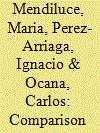| Srl | Item |
| 1 |
ID:
093541


|
|
|
|
|
| Publication |
2010.
|
| Summary/Abstract |
Energy intensity in Spain has increased since 1990, while the opposite has happened in the EU15. Decomposition analysis of primary energy intensity ratios has been used to identify which are the key sectors driving the Spanish evolution and those responsible for most of the differences with the EU15 energy intensity levels. It is also a useful tool to quantify which countries and economic sectors have had most influence in the EU15 evolution. The analysis shows that the Spanish economic structure is driving the divergence in energy intensity ratios with the EU15, mainly due to strong transport growth, but also because of the increase of activities linked to the construction boom, and the convergence to EU levels of household energy demand. The results can be used to pinpoint successful EU strategies for energy efficiency that could be used to improve the Spanish metric.
|
|
|
|
|
|
|
|
|
|
|
|
|
|
|
|
| 2 |
ID:
116749


|
|
|
|
|
| Publication |
2012.
|
| Summary/Abstract |
While support instruments have succeeded to largely deploy renewables during the 1996-2008 period, little attention has been paid to energy efficiency measures, resulting in a high energy intensity and large growth of energy demand. Energy-related CO2 emissions have increased significantly. At the same time, important investments in combined cycle gas turbines have taken place. This paper analyses whether, from a cost minimization viewpoint, renewable support has been the best policy for reducing emissions, when compared to the promotion of energy efficiency in sectors such as transportation or buildings. We use a model of the Spanish energy sector to examine its evolution in the time period considered under different policies. It is a bottom-up, static, partial equilibrium, linear programming model of the complete Spanish energy system. We conclude that demand side management (DSM) clearly dominates renewable energy (RE) support if the reduction of emissions at minimum cost is the only concern. We also quantify the savings that could have been achieved: a total of €5 billion per year, mainly in RE subsidies and in smaller costs of meeting the reduced demand (net of DSM implementation cost).
|
|
|
|
|
|
|
|
|
|
|
|
|
|
|
|